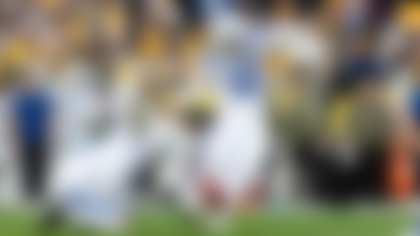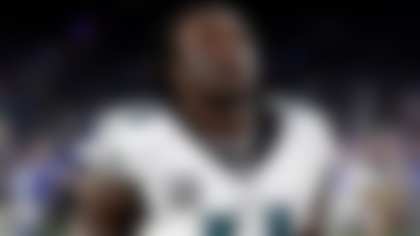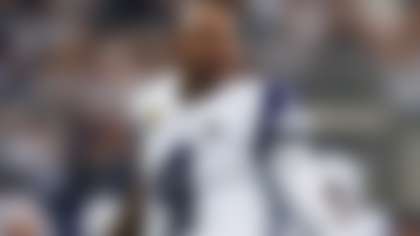Whenever I speak to a young player trying to make his mark in the NFL, I advise him to find a Pro Bowler with similar skills and attempt to copy his career blueprint.
I'm aware that most youngsters already model their games after the elite talents at their respective positions. However, I believe it is important for ascendant players to specifically follow veterans with nearly identical physical abilities, because they can show them how to best take advantage of those abilities and carve out a successful pro legacy.
When I was a young defensive back for the Kansas City Chiefs in the late 1990s, I had a pair of All-Pro mentors in Dale Carter and James Hasty. Those guys spent countless hours on the practice field giving me pointers on the fundamentals of bump-and-run coverage while also showing me how to study film and prepare. Hasty in particular would meet with me on Tuesday mornings (the players' day off) in the film room to help me get ready for my matchup at the end of the week. Thanks to his willingness to share his knowledge and experience, I was able to avoid making some of the mistakes that inexperienced cornerbacks make. The veteran showed me how to be a pro and what it took to become a successful player in the league.
Looking ahead to the 2014 NFL season, I see several young players with terrific opportunities to learn from Pro Bowl teammates in their position group. If these rookies are inclined to tap their veteran counterparts' experience and expertise, they could develop quickly at the pro level and make immediate contributions.
Below, I've specified what eight such rookies can learn from the wily veterans occupying their meeting rooms in training camp:
Mentor: J.J. Watt
The No. 1 overall pick in the 2014 NFL Draft has been hailed as one of the best defensive prospects to ever enter the league, but questions about Clowney's work ethic and desire have sparked doubts about his ability to realize his potential as a pro. Watt -- the 2012 Defensive Player of the Year -- is arguably the top defender in the NFL. The three-year veteran has totaled 36.5 sacks, eight forced fumbles, six fumble recoveries and 27 passes defensed, exhibiting exceptional athleticism, strength and power at the point of attack. Additionally, Watt leads the league with 108 quarterback hits and 74 tackles for loss since the Texans drafted him in the first round in 2011.
Jeremiah: Rookies to watch in camp
The NFL ropes can be tough for even the most talented rookies to learn. Daniel Jeremiah lists 11 to track in training camp. **READ**
What can Clowney learn from Watt? For all of the pass-rush tips and techniques Watt can share with Clowney in meetings, it is Watt's non-stop motor and relentless spirit that could truly help the rookie thrive early on. Watt consistently outworks opponents at the point of attack, and his hustle ensures he is never out of the play. Watt is also regarded as someone who brings a tireless approach to the preparation phase of the game. Clowney could reap tremendous benefits from watching the Pro Bowler hone his craft both on and off the field.
Mentor: Matt Schaub
The Raiders' quarterback of the future will have the opportunity to learn from the sidelines as a rookie. While many give Carr an outside shot of winning the top job in the preseason, Oakland would be wise to let him develop on the practice field until he is ready to take the reins from Schaub.
Skeptics question whether Schaub -- shipped out of Houston following a disappointing 2013 campaign -- has the goods to be a quality NFL starter, but his history of solid production in former Texans coach Gary Kubiak's system suggests Schaub's doubters might be dismissing him prematurely. The 10-year veteran has three 4,000-yard seasons under his belt and sports an impressive 130:84 touchdown-to-interception ratio. With the Raiders running a similar offensive scheme, Schaub has a lot to offer.
What can Carr learn from Schaub? Schaub is probably not interested in serving as a mentor at this stage of his career, but the two-time Pro Bowler can still teach Carr some valuable lessons and show him how to master the nuances of the position, from commanding the huddle to operating efficiently at the line of scrimmage. Additionally, Carr can watch how Schaub -- who has 90 regular-season starts on his resume -- prepares throughout the week to gain a better understanding of what it takes to be the leader of the team. If Carr and Schaub can coexist peacefully in the QB meeting room, the rookie could grow immensely.
Mentor: Vincent Jackson
Evans is a playmaker with the size, speed and athleticism to thrive as a vertical stretch receiver. Most important, he is a big-bodied pass catcher with the tools to blossom into a No. 1 receiver down the road.
Bucs coach Lovie Smith added Evans to the lineup to give Tampa Bay a dynamic weapon on the perimeter opposite Jackson, a three-time Pro Bowler who has topped the 1,000-yard mark five times in nine seasons while emerging as one of the best receivers in the NFL. Jackson is a rare No. 1 receiver capable of running every route in the book, including the vertical portion of the route tree (go-route, post and corner). Additionally, he is a powerful runner who excels at turning short passes into big gains. Thus, Jackson averages 17.4 yards per catch for his career, which places him among the league's leaders in that category since his arrival in 2005.
What can Evans learn from Jackson? Jackson entered the league as a complementary receiver for the San Diego Chargers before developing into what he is today. He can help Evans master the nuances of route running on the perimeter, while also helping him understand how to defeat the double teams that are typically directed at the offense's primary receiver. Jackson led the league with 19.2 yards per catch in 2012 despite facing a ton of double coverage; he can pass on that knowledge to Evans to prepare him for a big role in the Buccaneers' offense.
Mentor: Michael Roos
The Titans opted to take the best player available with the 11th overall pick in 2014, grabbing a standout offensive tackle capable of starting on the blind side with his combination of size, strength and athleticism. Lewan capably dances with finesse rushers in pass protection and also exhibits the power and explosiveness to move defenders off the ball in the run game. Given his solid overall skills, Lewan has the potential to develop into a Pro Bowler.
Roos has been a solid starter for the Titans since entering the league in 2005 as a small-school standout from Eastern Washington. After beginning his career as a right tackle, Roos blossomed into a Pro Bowl-caliber left tackle for the Titans. His superb technical skills and combination of size and strength allow him to stalemate elite pass rushers off the edge and move defenders off the ball in the run game. Given Roos' solid play and durability (he's started 143 of 144 possible regular-season contests in 10 campaigns), he is the ideal role model for Lewan.
What can Lewan learn from Roos? Any player who has enjoyed a 10-year career in the NFL has plenty of experience and wisdom to share. Lewan should pick Roos' brain to see how he successfully transitioned to the pro game and made the move from right to left tackle. Additionally, Lewan can ask the veteran for tips on strength and conditioning, in the hopes of avoiding serious injury on the edge.
Mentor: Charles Tillman
The Bears wanted to pick up a young cornerback to groom for a key role down the road, and Fuller is a spectacular athlete with exceptional length and superb technical skills. Although he is at his best playing press-man coverage, Fuller's aggressiveness and physicality mesh well with the Bears' Tampa 2 scheme. In addition, he is a versatile defender capable of playing nickel corner or safety in exotic packages.
Tillman has been a takeaway machine throughout his career, collecting 36 picks and 42 forced fumbles in 154 games. The two-time Pro Bowler's proficiency generating turnovers -- particularly fumbles -- is unrivaled at his position. The veteran's cover skills, instincts and anticipation allow him to thrive in a scheme that routinely creates takeaway chances off tips and overthrows. The presence of a ball magnet like Tillman helps the Bears' defense produce enough game-changing plays to keep the team in contention down the stretch.
What can Fuller learn from Tillman? To generate significant takeaway production in the NFL, defenders must have a knack for anticipating plays in their areas and aggressively attack the ball at every opportunity. Given Tillman's prowess as a turnover machine, Fuller should spend every free moment studying the veteran's footwork and technique in coverage. He should also attempt to mimic Tillman's powerful pocket punch, which routinely dislodges the ball from runners on the perimeter. A full season watching the veteran at work could help Fuller quickly become a disruptive force in the secondary.
Mentor: Frank Gore
To the surprise of many, Hyde plummeted down the charts in the draft, going in the second round to the Niners despite posting impressive production as the Big Ten Conference's leading rusher in 2013. The 6-foot, 230-pound Ohio State product is a rock-solid downhill runner with outstanding vision, balance and body control. He's an ideal fit in the 49ers' offense as a "banger" with the toughness, physicality and nasty disposition to do the dirty work between the tackles.
Maquinana: Foiling Father Time

Frank Gore's injury-plagued college career is a distant memory. Ryan Maquinana studies the San Francisco back's rare longevity. **READ**
Gore has been the model of consistency at the position since emerging as the 49ers' starter in 2006. The five-time Pro Bowler has topped the 1,000-yard mark in seven different seasons while gaining 4.6 yards per carry throughout his career. Beyond the numbers, Gore is a hard-nosed runner who sets the tone for San Francisco with his rugged style; he creates opportunities in the passing game with his mere presence in the backfield. It's not a stretch to suggest Gore remains the team's top offensive player despite entering his 10th pro season.
What can Hyde learn from Gore? The rookie would do well to simply watch Gore take the majority of the reps in 9-on-7 (inside run) drills and team drills. One of the most patient runners I've seen in the hole, Gore also displays the balance, body control and burst to explode to the second level. He rarely misses a crease when it develops in traffic, and his efficient footwork results in positive gains despite missed blocks at the point of attack. Additionally, Gore is an exceptional blocker and receiver in the passing game, meaning the 49ers aren't required to take him off the field in any situation.
Hyde should study how Gore became a true "three-down" back and emulate the veteran's approach to everything from film study and game-plan preparation to his pre-practice routine. Hyde should also pepper the veteran with questions to get a better understanding of what it takes to be an elite player. If Hyde pays close attention to how Gore goes about his business, he could become a star performer in the 49ers' offense by next season.
Mentor: Tamba Hali
Ford was arguably the most explosive pass rusher in college football in 2013; he's a natural with a dominant "dip-and-rip" move that makes him nearly impossible to block in one-on-one situations. This was apparent when Ford overwhelmed the competition at the Senior Bowl. He was too fast and explosive for lumbering offensive tackles. The 6-2, 252-pound Ford -- who shows exceptional first-step quickness and burst coming off the edge -- also exhibits the ability to turn speed into power on bull rushes. As a result, Ford has the potential to wreak havoc on foes from an edge-rusher spot.
Hali is a dynamic pass rusher off the edge who flashes extraordinary first-step quickness and burst attacking the quarterback; he's also capable of turning his speed into power by exploding into blockers down the middle. With offensive tackles unable to deal with his fastball (speed rush) or changeup (bull rush), Hali has produced, notching at least 10 sacks in three of the past four seasons and forcing 13 fumbles during that span. With his impact and effectiveness as a disruptive playmaker off the edge, Hali has earned four straight Pro Bowl bids while becoming one of the most feared pass rushers in the game.
What can Ford learn from Hali? It's uncommon for a team to have a stable of rushers with similar skills, but the Chiefs boast three explosive edge players (Ford, Hali and Justin Houston) with extraordinary first-step quickness and acceleration. Hali and Houston have quickly developed an impressive array of counter moves to help them handle the various tactics offensive tackles use to thwart their rush attempts off the edge. Ford should adopt a few of the veterans' tricks to help him stay ahead of the game when offensive tackles catch up to his speed rush and "dip-and-rip" maneuver. Additionally, Ford should quiz Hali on how to anticipate the snap count to gain an additional step on opponents at the line of scrimmage. If Ford can add a move or two to his repertoire early in his career, he could become a disruptive force for the Chiefs as a designated pass rusher.
Mentor: Victor Cruz
The Giants needed to add a young, dynamic receiver to the mix after losing Hakeem Nicks to free agency. Beckham is an explosive playmaker with the speed and quickness to stretch the field on vertical routes. He's also a dangerous runner who can produce big plays on "catch-and-run" passes. With Beckham capable of delivering explosive plays as an electric kick returner, the Giants have added some much needed firepower to a pedestrian offense.
Not only is Cruz the top slot receiver in pro football, but he is an explosive playmaker capable of scoring from anywhere on the field. The Pro Bowler is a rare find at the position because he can do all of the dirty work between the hashes and has the speed and quickness to excel outside the numbers on intermediate and vertical routes. Additionally, the fifth-year pro is a dangerous red-zone weapon with a knack for putting the ball in the paint (23 career touchdowns) as Eli Manning's primary option in the Giants' passing game.
What can Beckham learn from Cruz? Learning how to run "pro" routes is one of the biggest challenges that face rookie receivers, who often need a few seasons of experience to fully grasp the importance of patience, timing and depth discipline as a route runner. Beckham should pay close attention to how Cruz executes various routes in the Giants' scheme to gain a better understanding of the liberties that he can take with his routes. In addition, he should copy some of Cruz's releases and stems to help him create significant separation from defenders at the top of routes. Given Cruz's reputation as one of the best route runners in the game, Beckham would be wise to lean on the veteran's knowledge and expertise to help him master the skill that could propel him from good to great.
Follow Bucky Brooks on Twitter @BuckyBrooks.












